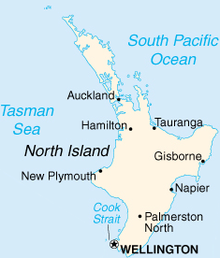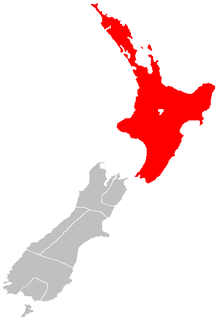North Island: Difference between revisions
m Reverted edits by Jacob Koopa (talk) to last version by WikitanvirBot |
No edit summary |
||
| Line 8: | Line 8: | ||
| local name = ''[[Te Ika-a-Māui]]'' (''[[Māori language|Māori]]'') |
| local name = ''[[Te Ika-a-Māui]]'' (''[[Māori language|Māori]]'') |
||
| nickname = |
| nickname = |
||
| location = [[Oceania]] |
| location = [[Oceania]]3|E|scale:5000000|display=inline}} |
||
| coordinates = {{coord|38|24|S|175|43|E|scale:5000000|display=inline}} |
|||
| archipelago = [[New Zealand]] |
| archipelago = [[New Zealand]] |
||
| total islands = |
| total islands = |
||
Revision as of 15:04, 2 February 2012
 | |
| Geography | |
|---|---|
| Location | Oceania3 |
| archipelago = New Zealand | total islands = | major islands = | area_km2 = 113729 | rank = 14th | highest mount = Mount Ruapehu | elevation_m = 2797 | country = New Zealand | country admin divisions title = ISO 3166-2:NZ | country admin divisions = NZ-N | country admin divisions title 1 = Regions | country admin divisions 1 = 9 | country admin divisions title 2 = Territorial authorities | country admin divisions 2 = 43 | country capital city = | country largest city = Auckland | country largest city population = 1,570,100 | country leader title = | country leader name = | population = 3,702,300 | population as of = June 2018 | density_km2 = 32.6 | ethnic groups = | additional info = }} The North Island (Māori: Te Ika-a-Māui) is one of the two main islands of New Zealand, separated from the much less populous South Island by Cook Strait. The island is 113,729 square kilometres (43,911 sq mi) in area,[1] making it the world's 14th-largest island. It has a population of 3,702,300 (June 2018).[2]
Twelve cities are in the North Island: Auckland, New Plymouth, Tauranga, Gisborne, Napier, Hamilton, Hastings, Palmerston North, Rotorua, Wanganui, Whangarei and Wellington, the capital, located at the southern extremity of the island. Approximately 76% of New Zealand's population lives in the North Island.
Naming and usage
Although the island has been known as the North Island for many years,[3] the New Zealand Geographic Board has found that, along with the South Island, it has no official name. The board intends to make North Island the island's official name, along with an alternative Māori name. Although several Māori names have been used, Maori Language Commissioner Erima Henare sees Te Ika-a-Māui as the most likely choice.[4]
The definite article is used with the names of the North and South islands, as the North Island and the South Island, like the North Sea and the Western World, but unlike Rangitoto Island or West Point. Maps, headings or tables and adjectival expressions use North Island, whereas the North Island is used after a preposition or before or after a verb, e.g. my mother lives in the North Island, the North Island is smaller than the South Island, or I'm visiting the North Island. When specifying that the island is where a place, person, or object is located, it is normal to use the word in rather than on, for example Hamilton is in the North Island.
Māori mythology
According to Māori mythology, the North and South Islands of New Zealand arose through the actions of the demigod Māui. Māui and his brothers were fishing from their canoe (the South Island) when he caught a great fish and pulled it from the sea. While he was not looking his brothers fought over the fish and chopped it up. This great fish became the North Island and thus a Māori name for the North Island is Te Ika-a-Māui (The Fish of Māui). The mountains and valleys are believed to have been formed as a result of Māui's brothers' hacking at the fish. Until the early 20th Century, an alternative Māori name for the North Island was Aotearoa. In present Māori usage, Aotearoa is a collective name for New Zealand as a whole.
Economy
The sub-national GDP of the North Island was estimated at US$102.863 billion in 2003, 79% of New Zealand's national GDP.[5]
Ecology
The North Island has an extensive flora and bird population, with numerous National Parks and other protected areas.
Regions of the North Island
Nine local government regions cover the North Island and all its adjacent islands and territorial waters.
Cities and towns in the North Island

- Auckland
- Gisborne
- Hamilton
- Hastings
- Masterton
- Napier
- New Plymouth
- Palmerston North
- Rotorua
- Taupo
- Tauranga
- Wanganui
- Whangarei
- Wellington
Smaller urban areas are found on the List of towns in New Zealand, as are components of larger metropolitan area.
Geographic features

- Cape Reinga
- East Cape
- Cape Palliser
- Lake Taupo
- Mt Maunganui Beach
- Tongariro National Park
- Taumatawhakatangihangakoauauotamateapokaiwhenuakitanatahu
- Waikato River
- Waipoua Kauri Forest
- Waitomo Caves
- Ninety Mile Beach
See also
References
- ^ Statistics New Zealand Geography - physical features
- ^ "Subnational Population Estimates: At 30 June 2019". Statistics New Zealand. 22 October 2019. Retrieved 11 January 2020. For urban areas, "Subnational population estimates (UA, AU), by age and sex, at 30 June 1996, 2001, 2006–18 (2017 boundaries)". Statistics New Zealand. 23 October 2018. Retrieved 23 October 2018.
- ^ On some 19th century maps, the North Island is named New Ulster, which was also a province of New Zealand that included the North Island.
- ^ Davison, Isaac (22 April 2009). "North and South Islands officially nameless". The New Zealand Herald. Retrieved 1 November 2011.
- ^ "Regional Gross Domestic Product". Statistics New Zealand. 2007. Retrieved 18 February 2010.
